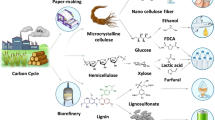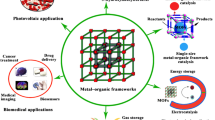Abstract
A series of nanosized cerium dioxide particles coated with Pluronic P123, poly(vinyl alcohol) (PVA) or titanium oxide are prepared through a sol-gel process. Characterizations reveal sizes of cerium dioxide particles are maintained below 15 nm along with good crystallinity, and their crystal forms could be modulated by calcination. Furthermore, the organic components such as Pluronic P123 and PVA could be incorporated during sol-gel and affect sample porosity, while loading of titanium into cerium dioxide improves acid amount of sol-gel product. Catalysis reveals both PVA and titanium components show obvious and significant thermo- and pH-responsive properties for conversion of d-(−)-fructose into 5-(hydroxymethyl)-furfural, which mean a lot to the future large-scale production of biomass-derived fine chemicals. This work would not only contribute to the development of stimuli-responsive materials, but also show their promising application for conversion of biomass to platform molecules.

The cerium dioxide-based materials having stimuli-responsive components that obtained through adjustable sol-gel process bring about highly efficient conversion of d-(-)-fructose into important platform molecules.
Highlights
-
The cerium dioxide nanoparticles that coated with Pluronic P123 and poly(vinyl alcohol), or titanium dioxide are prepared through sol-gel.
-
The coated components such as poly(vinyl alcohol) and titanium dioxide show significant thermo- and pH-responsive properties during catalytic conversion of d-(-)-fructose into platform molecules.
-
High yields of platform molecules could be obtained in water at 20 °C, and synthetic catalysts show satisfactory recycling behaviors.













Similar content being viewed by others
References
Reed K, Cormack A, Kulkarni A, Mayton M, Sayle D, Klaessig F, Stadler B (2014) Exploring the properties and applications of nanoceria: is there still plenty of room at the bottom? Environ Sci Nano 1:309–405
Hussain S, Al-Nsour F, Rice AB, Marshburn J, Yingling B, Ji Z, Zink JI, Walker NJ, Garantziotis S (2012) Cerium dioxide nanoparticles induce apoptosis and autophagy in human peripheral blood monocytes. ACS Nano 6:5820–5829
Zhang G, Xu J, Hou Z, Wang Q (2017) Research on micro-structure and catalysis properties of nanosized Ce1-x(Fe0.5Eu0.5)O2-δ solid solutions. J Rare Earths 35:63–70
Sun C, Li H, Chen L (2012) Nanostructured ceria-based materials: synthesis, properties, and applications. Energy Environ Sci 5:8475–8505
Vinodkumar T, Durgasri DN, Reddy BM, Alxneit I (2014) Synthesis and structural characterization of Eu2O3 doped CeO2: influence of oxygen defects on CO oxidation. Catal Lett 144:2033–2042
Hernández WY, Centeno MA, Romero-Sarria F, Odriozola JA (2009) Synthesis and characterization of Ce1-xEuxO2-x/2 mixed oxides and their catalytic activities for CO oxidation. J Phys Chem C 113:5629–5635
Jasinski P, Suzuki T, Anderson HU (2003) Nanocrystalline undoped ceria oxygen sensor. Sens Actuators B 95:73–77
Ketpang K, Lee K, Shanmugam S (2014) Facile synthesis of porous metal oxide nanotubes and modified nafion composite membranes for polymer electrolyte fuel cells operated under low relative humidity. ACS Appl Mater Interfaces 6:16734–16744
Johnson AC, Park B (2012) Predicting contamination by the fuel additive cerium oxide engineered nanoparticles within the United Kingdom and the associated risks. Environ Toxicol Chem 31:2582–2587
Cai G, Lu H, Zhou Y, Hao J, Wilkie CA (2012) Fire retardancy of emulsion polymerized poly (methyl methacrylate)/cerium(IV) dioxide and polystyrene/cerium(IV) dioxide nanocomposites. Thermochim Acta 549:124–131
Hasannejad H, Shahrabi T, Jafarian M (2013) Synthesis and properties of high corrosion resistant Ni-cerium oxide nano-composite coating. Mater Corros 64:1104–1113
Zhang J, Zhang M, Tang K, Verpoort F, Sun T (2014) Polymer-based stimuli-responsive recyclable catalytic systems for organic synthesis. Small 10:32–46
Gao L, Kong T, Huo Y (2016) Dual thermoresponsive and pH-responsive poly(vinyl alcohol) derivatives: synthesis, phase transition study, and functional applications. Macromolecules 49:7478–7489
Slavinskaya EM, Kardash TYu, Stonkus OA, Gulyaev RV, Lapin IN, Svetlichnyi VA, Boronin AI (2016) Metal-support interaction in Pd/CeO2 model catalyst for CO oxidation: from pulsed laser-ablated nanoparticles to highly active state of the catalyst. Catal Sci Technol 6:6650–6666
Wilklow-Marnell M, Jones WD (2017) Catalytic oxidation of carbon monoxide by α-alumina supported 3 nm cerium dioxide nanoparticles. Mol Catal 439:9–14
Qureshi U, Dunnill CW, Parkin IP (2009) Nanoparticulate cerium dioxide and cerium dioxide-titanium dioxide composite thin films on glass by aerosol assisted chemical vapour deposition. Appl Surf Sci 256:852–856
Channei D, Nakaruk A, Phanichphant S (2009) Influence of graphene oxide on photocatalytic enhancement of cerium dioxide. Mater Lett 209:43–47
Shibata K, Kiyoura T, Kitagawa J, Sumiyoshi T, Tanabe K (1973) Acidic properties of binary metal oxides. Bull Chem Soc Jpn 46:2985–2988
Sidheswaran M, Tavlarides LL (2009) Characterization and visible light photocatalytic activity of cerium- and iron-doped titanium dioxide sol-gel materials. Ind Eng Chem Res 48:10292–10306
Katalenich JA (2017) Production of cerium dioxide microspheres by an internal gelation sol-gel method. J Sol-Gel Sci Technol 82:654–663
Han X, Li L, Wang C (2013) Template-free synthesis of uniform single-crystal hollow cerium dioxide nanocubes and their catalytic activity. Nanoscale 5:7193–7196
Lange J-P, Price R, Ayoub PM, Louis J, Petrus L, Clarke L, et al. (2010) Valeric biofuels: a platform of cellulosic transportation fuels Angew Chem Int Ed 49:4479–4483
Alonso DM, Bond JQ, Serrano-Ruiz JC, Dumesic JA (2010) Production of liquid hydrocarbon transportation fuels by oligomerization of biomass-derived C9 alkenes. Green Chem 12:992–999
Hu L, Lin L, Wu Z, Zhou S, Liu S (2017) Recent advances in catalytic transformation of biomass-derived 5-hydroxymethylfurfural into the innovative fuels and chemicals. Renew Sustain Energy Rev 74:230–257
Wang S, Zhang Z, Liu B, Li J (2013) Silica-coated magnetic Fe3O4 nanoparticles supported phosphotungstic acid: a novel environmentally friendly catalyst for the synthesis of 5-ethoxymethylfurfural from 5-hydroxymethylfurfural and fructose. Catal Sci Technol 3:2104–2112
Delidovich I, Hausoul PJC, Deng L, Pfützenreuter R, Rose M, Palkovits R (2016) Alternative monomers based on lignocellulose and their use for polymer production. Chem Rev 116:1540–1599
Besson M, Gallezot P, Pinel C (2014) Conversion of biomass into chemicals over metal catalysts. Chem Rev 114:1827–1870
Wang F, Jiang L, Wang J, Zhang Z (2016) Catalytic conversion of fructose and 5-hydroxymethylfurfural into 2,5-diformylfuran over SBA-15 supported ruthenium catalysts. Energy Fuels 30:5885–5892
Wang T, Nolte MW, Shanks BH (2014) Catalytic dehydration of C6 carbohydrates for the production of hydroxymethylfurfural (HMF) as a versatile platform chemical. Green Chem 16:548–572
Watanabe M, Aizawa Y, Iida T, Nishimura R, Inomata H (2005) Catalytic glucose and fructose conversions with TiO2 and ZrO2 in water at 473 K: relationship between reactivity and acid-base property determined by TPD measurement. Appl Catal A 295:150–156
Dutta S, De S, Patra AK, Sasidharan M, Bhaumik A, Saha B (2011) Microwave assisted rapid conversion of carbohydrates into 5-hydroxymethylfurfural catalyzed by mesoporous TiO2 nanoparticles. Appl Catal A 409-410:133–139
Ko H-H, Yang G, Cheng H-Z, Wang M-C, Zhao X (2014) Growth and optical properties of cerium dioxide nanocrystallites prepared by coprecipitation routes. Ceram Int 40:4055–4064
Chen D, He D, Lu J, Zhong L, Liu F, Liu J, Yu J, Wan G, He S, Luo Y (2017) Investigation of the role of surface lattice oxygen and bulk lattice oxygen migration of cerium-based oxygen carriers: XPS and designed H2-TPR characterization. Appl Catal B Environ 218:249–259
Viornery C, Chevolot Y, Léonard D, Aronsson B-O, Péchy P, Mathieu HJ, Descouts P, Grätzel M (2002) Surface modification of titanium with phosphonic acid to improve bone bonding: characterization by XPS and ToF-SIMS. Langmuir 18:2582–2589
Gionco C, Paganini MC, Agnoli S, Reeder AE, Giamello E (2013) Structural and spectroscopic characterization of CeO2-TiO2 mixed oxides. J Mater Chem A 1:10918–10926
Nethravathi C, Rajamathi CR, Rajamathi M, Wang X, Gautam UK, Golberg D, Bando Y (2014) Cobalt hydroxide/oxide hexagonal ring-graphene hybrids through chemical etching of metal hydroxide platelets by graphene oxide: energy storage applications. ACS Nano 8:2755–2765
Chen H-R, Shi J-L, Zhang W-H, Ruan M-L, Yan D-S (2001) Incorporation of titanium into the inorganic wall of ordered porous zirconium oxide via direct synthesis. Chem Mater 13:1035–1040
Sing KSW, Everett DH, Haul RAW, Moscou L, Pierotti RA, Rouquérol J, Siemieniewska T (1985) Reporting physisorption data for gas/solid systems with special reference to the determination of surface area and porosity. Pure Appl Chem 57:603–619
Zhang H, Zhang Y, Li C (2006) Enantioselective epoxidation of unfunctionalized olefins catalyzed by the Mn(salen) catalysts immobilized in the nanopores of mesoporous materials. J Catal 238:369–381
Huang B, Fan C, Pan C, Zheng A, Ma X, Li Y, Zhang J, Sun Y (2017) Synthesis and catalytic oxidation property of titanium-zirconium mixed oxide microsphere as well as microcube. Powder Technol 315:258–269
Barroso-Bogeat A, Alexandre-Franco M, Fernández-González C, Macías-García A, Gómez-Serrano V (2016) Preparation of activated carbon-SnO2, TiO2, and WO3 catalysts. Study by FT-IR spectroscopy. Ind Eng Chem Res 55:5200–5206
Gonzalez-Calderon JA, Vallejo-Montesinos J, Almendarez-Camarillo A, Montiel R, Pérez E (2016) Non-isothermal crystallization analysis of isotactic polypropylene filled with titanium dioxide particles modified by a dicarboxylic acid. Thermochim Acta 631:8–17
Crestani CE, Bernardo A, Costa CBB, Giulietti M (2013) Fructose solubility in mixed (ethanol + water) solvent: Experimental data and comparison among different thermodynamic models. J Chem Eng Data 58:3039–3045
Flood AE, Addai-Mensah J, Johns MR, White ET (1996) Refractive index, viscosity, density, and solubility in the system fructose + ethanol + water at 30, 40, and 50 °C. J Chem Eng Data 41:418–421
Li H-B, Page AJ, Irle S, Morokuma K (2013) Temperature dependence of catalyst-free chirality-controlled single-walled carbon nanotube growth from organic templates. J Phys Chem Lett 4:3176–3180
Roberts JJ, Naudiyal P, Jugé L, Bilston LE, Granville AM, Martens PJ (2015) Tailoring stimuli responsiveness using dynamic covalent cross-linking of poly (vinyl alcohol)-heparin hydrogels for controlled cell and growth factor delivery. ACS Biomater Sci Eng 1:1267–1277
Zheng L-S, Llopis Q, Echeverria P-G, Férard C, Guillamot G, Phansavath P, Retovelomanana-Vidal V (2017) Asymmetric transfer hydrogenation of (hetero)arylketones with tethered Rh(III)-N-(p-tolylsulfonyl)-1,2-diphenylethylene-1,2-diamine complexes: scope and limitations. J Org Chem 82:5607–5615
Ali FM, Kershi RM, Sayed MA, AbouDeif YM (2018) Evaluation of structural and optical properties of Ce3+ ions doped (PVA/PVP) composite films for new organic semiconductors. Phys B Condens Matter 538:160–166
Flannelly T, Dooley S, Leahy JJ (2015) Reaction pathway analysis of ethyl levulinate and 5-ethoxymethylfurfural from d-fructose acid hydrolysis in ethanol. Energy Fuels 29:7554–7565
Santos-Filho OA, Hopfinger AJ (2006) Structure-based QSAR analysis of a set of 4-hydroxy-5,6-dihydropyrones as inhibitors of HIV-1 protease: an application of the receptor-dependent (RD) 4D-QSAR formalism. J Chem Inf Model 46:345–354
Long J, Hu J, Shen X, Ji B, Ding K (2002) Discovery of exceptionally efficient catalysts for solvent-free enantioselective Hetero-Diels-Alder reaction. J Am Chem Soc 124:10–11
Hiyoshi N (2012) Nanocrystalline sodalite: preparation and application to epoxidation of 2-cyclohexen-1-one with hydrogen peroxide. Appl Catal A 419-420:164–169
Alhassan FH, Rashid U, Taufiq-Yap YH (2015) Synthesis of waste cooking oil-based biodiesel via effectual recyclable bi-functional Fe2O3_MnO_SO4 2-/ZrO2 nanoparticle solid catalyst. Fuel 142:38–45
Acknowledgements
This study is supported by the Fundamental Research Funds for the Central Universities (xjj2014005). This work is also supported by Undergraduate Teaching Reform Research Project (No. 1620Y) and Basic Course Teaching Reform Project (No. 1602Z-04) of Xi'an Jiaotong University.
Author information
Authors and Affiliations
Corresponding authors
Ethics declarations
Conflict of interest
The authors declare that they have no conflict of interest.
Electronic supplementary material
Rights and permissions
About this article
Cite this article
Fan, C., Pan, W., Wang, W. et al. Sol-gel synthesis of cerium dioxide nanoparticles coated with stimuli-responsive components and the application for conversion of d-(−)-fructose into platform molecules. J Sol-Gel Sci Technol 88, 141–162 (2018). https://doi.org/10.1007/s10971-018-4771-2
Received:
Accepted:
Published:
Issue Date:
DOI: https://doi.org/10.1007/s10971-018-4771-2




